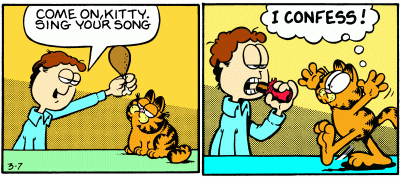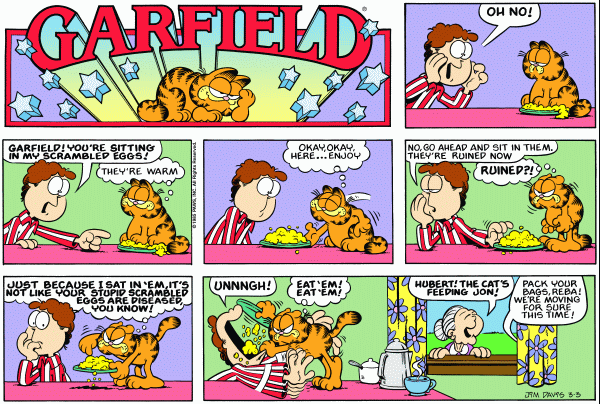
Garfield is a comic strip created by Jim Davis. Published since June 19, 1978, it chronicles the life of the title character, the cat Garfield (named after Davis's grandfather); his owner, Jon Arbuckle; and Jon's dog, Odie. As of 2013, it was syndicated in roughly 2,580 newspapers and journals, and held the Guinness World Record for being the world's most widely syndicated comic strip.[1]

Though this is rarely mentioned in print, Garfield is set in Muncie, Indiana, the home of Jim Davis, according to the television special Happy Birthday, Garfield. Common themes in the strip include Garfield's laziness, obsessive eating, and hatred of Mondays and diets. The strip's focus is mostly on the interactions among Garfield, Jon, and Odie, but recurring minor characters appear as well. Originally created with the intentions to "come up with a good, marketable character", Garfield has spawned merchandise earning $750 million to $1 billion annually. In addition to the various merchandise and commercial tie-ins, the strip has spawned several animated television specials, two animated television series, two theatrical feature-length live-action films and three CGI animated direct-to-video movies. Part of the strip's broad appeal is due to its lack of social or political commentary; though this was Davis's original intention, he also admitted that his "grasp of politics isn't strong", remarking that, for many years, he thought "OPEC was a denture adhesive".[2][3]


Garfield's first Sunday page ran on June 25, 1978,[8] being featured as a third-pager until March 22, 1981.[9] A half page debuted the following Sunday (March 29),[10] with the strips for March 14[11] and 21, 1982,[12] having a unique nine-panel format, but UFS curtailed further use of it (but it allowed Davis to use the format for his U.S. Acres strip).

The strip's subject matter in the early months varied from the pattern it later settled into. Some could be seen today as politically incorrect, such as strips involving Jon's pipe smoking[13][14][15] or his subscription to a bachelor magazine.[16] Another point which has distanced these strips was the U.S./Canada-centric humor, with a few jokes being totally untranslatable to some languages,[17] however by 1980, the strip became the universal family fare product for which it is now known.

More notably, the strip underwent stylistic changes with 1978–83 strips being more realistic, while comics from 1984 onwards have been more cartoony. This change has essentially affected Garfield's design; who underwent a "Darwinian evolution" in which he began walking on his hind legs, "slimmed down", and "stopped looking [...] through squinty little eyes". His evolution, according to Davis, was to make it easier to "push Odie off the table" or "reach for a piece of pie". Jon also underwent major changes, and still currently is. Now, he looks older than 1990 strips; he is taller and he has larger features.

Garfield quickly became a commercial success. In 1981, less than three years after its release, the strip appeared in 850 newspapers and accumulated over $15 million in merchandise. To manage the merchandise, Davis founded Paws, Inc.[19] By 2002, Garfield became the world's most syndicated strip, appearing in 2,570 newspapers with 263 million readers worldwide;[1] by 2004, Garfield appeared in nearly 2,600 newspapers and sold from $750 million to $1 billion worth of merchandise in 111 countries.[20] In 1994, Davis's company, Paws, Inc., purchased all rights to the strips from 1978 to 1993 from United Feature. The strip is currently distributed by Universal Press Syndicate, while rights for the strip remain with Paws.

While retaining creative control and being the only signer, Davis now only writes and usually does the rough sketches. Since the late 1990s most of the work has been done by long-time assistants Brett Koth and Gary Barker. Inking and coloring work is done by other artists while Davis spends most of the time supervising production and merchandising of his characters.[20]

References
- ^ a b c "Garfield Named World's Most Syndicated Comic Strip.". Business Wire. January 22, 2002. Retrieved July 26, 2008.
- ^ Johnson, Beth (June 19, 1998). "Tales of the Kitty". Entertainment Weekly. Retrieved August 4, 2008.
- ^ "Everybody loves Garfield". The Star. Retrieved August 4, 2008.
- ^ Davis. 20 Years & Still Kicking!: Garfield's Twentieth Anniversary Collection. p. 14.
- ^ Hall, Gerrard (October 6, 2000). "The cat's meow". CNN. Retrieved July 26, 2008.
- ^ "The Garfield Vault Strip". June 19, 1978. Retrieved June 19, 2012.
- ^ "Those Catty Cartoonists (fee required)". Time. December 7, 1981. Retrieved July 26, 2008.
- ^ "The Garfield Vault Strip". June 25, 1978. Retrieved April 7, 2012.
- ^ "The Garfield Vault Strip". March 22, 1981. Retrieved April 7, 2012.
- ^ "The Garfield Vault Strip". March 29, 1981. Retrieved April 7, 2012.
- ^ "The Garfield Vault Strip". March 14, 1982. Retrieved April 7, 2012.
- ^ "The Garfield Vault Strip". March 21, 1982. Retrieved April 7, 2012.
- ^ "The Garfield Vault Strip". July 27, 1978. Retrieved April 7, 2012.
- ^ "The Garfield Vault Strip". July 28, 1978. Retrieved April 7, 2012.
- ^ "The Garfield Vault Strip". March 20, 1979. Retrieved April 7, 2012.
- ^ "The Garfield Vault Strip". October 28, 1978. Retrieved April 7, 2012.
- ^ "The Garfield Vault Strip". September 29, 1978. Retrieved April 7, 2012.
- ^ Barron, James (April 19, 2001). "Boldface Names". New York Times. Retrieved July 26, 2008.
- ^ "Those Catty Cartoonists". Time. December 7, 1981. p. 2. Retrieved July 26, 2008.
- ^ a b c d Suellentrop, Chris (June 11, 2004). "Why we don't hate Garfield.". Slate. Retrieved April 30, 2008.





No comments:
Post a Comment